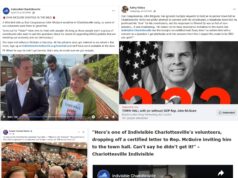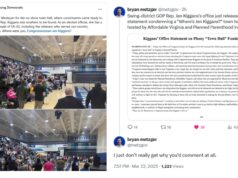First off, let me just say upfront that I strongly agree with my friend Josh Israel – one of the most astute political writers around, also one of the most knowledgeable about Virginia – that “gerrymandering” is a major problem in our fine Commonwealth. For years, I’ve strongly supported a shift to nonpartisan and/or bipartisan redistricting, but obviously the incumbents have had different ideas. Thus, we had the Democrats in the State Senate drawing their preferred lines after the 2010 census, the Republicans in the House their preferred lines, and the Virginia Congressional incumbents making sure that they were safe in their districts. It’s bad for democracy, it’s bad for Democrats (e.g., we basically locked in an 8-3 Republican advantage in the U.S. House of Representatives despite Virginia being a purplish-blue state), and it needs to change. But it won’t anytime soon, let’s face it, given the desire of incumbents to protect themselves at all costs. Which means we just have to deal with it the best we can.
That brings us back to reality – specifically, the actual situation we face, not the situation we (to paraphrase Donald Rumsfeld) the situation we might want or wish to have at a later time. So we’ve got these awful, gerrymandered, incumbent-protection districts. Lots of ’em. And Republicans have taken advantage, beginning the 2013 cycle with an overwhelming, 68-32 advantage in the Virginia House of Delegates. Plus a huge money advantage that comes from incumbency, plus controlling the Governor’s Mansion, plus being total corporate tools (of the fossil fuel companies, Dominion, you name it). Yeah, it sucks, but them there’s the facts we need to deal with -or go home and curl up in fetal position. I prefer the former to the latter.
But here’s the thing: despite all the advantages gerrymandering gave the Republicans heading into this cycle, we still had 18 districts won by Tim Kaine (and 16 districts won by Barack Obama) in 2012 that were potentially winnable. How do I know this? Because Tim Kaine and Barack Obama just won them a year ago. Which means our voters are there and we know who they are.
The challenge, of course, is that Democratic voters tend to turn out in much lower numbers, relatively speaking, than Republican voters in odd-year, non-federal elections. But that’s not etched in stone or anything, it’s just a phenomenon we’ve observed for several years now. Which means we can/should/MUST work to change it. And what better year to do that than right after Barack Obama and Tim Kaine won Virginia (and with the reams of Obama campaign data available to Virginia Democrats this year)? Especially with a Democratic statewide ticket (and a super-well-funded gubernatorial candidate able and willing to pour money into the “coordinated” campaign) poised to sweep the Republican “extreme team?” I’d also point out that Democratic turnout in the non-federal years is highest in a gubernatorial year. In other words, if we couldn’t pick up a bunch of House of Delegates seats THIS year, with our well-funded statewide ticket sweeping, and with 18 “Kaine districts” (and 16 “Obama districts”) currently held by Republican delegates, when will we ever?
So why DIDN’T we pick up more seats in the House of Delegates this cycle? I’ve been talking to people and looking at the numbers. I have not reached any definitive conclusions at this point. But one thing is clear: Democratic House of Delegates candidates frequently underperformed compared to the statewide candidates in their districts. Part of the problem, no doubt, was money. Several of our “targeted” candidates got outspent badly: Jennifer Boysko by more than 2:1 ($601k-$253k) in the 86th district general election campaign (despite this, she lost by just 54 votes!); Kathleen Murphy by more than $500k in the 34th district (despite this, she lost by just 422 votes); James Harder by a nearly 2:1 margin in the 12th; Elizabeth Miller by an incredible 20:1 margin a 2:1 margin in the 32nd (despite this, she lost by just 634 votes out of nearly 23,000 cast); Jeremy McPike by a whopping 4:1 margin in the 31st (despite this, McPike only lost by just 234 votes); Rob Farinholt was outspent by about $300k in the 94th district (yet lost by just 543 votes); Hung Nguyen by more than a 4:1 margin in the 67th (Nguyen lost 55%-45%); etc, etc. You think we might have won a few of these if the money had been a bit less lopsided than it was? Hmmm. (note: in this context, I should note that Democracy for America promised $750,000 to its targeted Virginia candidate, but only ended up spending a bit over $120,000 – #FAIL)
But it wasn’t just money. That’s often used as an excuse for everything, the be-all-end-all of politics. Well, sorry it, isn’t. Having worked on a race (Jim Webb for U.S. Senate in 2006) in which we were wildly outspent in the primary, then started the general election campaign absolutely broke and facing an entrenched incumbent (George Allen) with a huge warchest, I can attest first-hand to the fact that while money matters, there’s a LOT more to politics than that. It’s just laziness (and self-serving spin), frankly, among politicians, consultants, etc., to claim that all their problems stemmed from money, and that all their problems would be solved if they only had more of it. Not.
Second, my own personal observation is that Democratic candidates didn’t use all the tools at their disposal in the year 2013, and absolutely essential at this point. I’m talking, first and foremost, about social media. For instance, many of our candidates had only minimal Twitter followers (Qarni had 136; McPike had 98; Murphy had 291; Harder had 44; Nguyen had 215; Boysko had 304), and relatively small Facebook followings as well.
As for Democratic House candidates’ presence on the blogs…uh, WHAT presence on the blogs? Here at Blue Virginia, for instance, we offer a community blog, which means that any of these Democratic campaigns could have registered an account (and their supporters could have registered many more), then posted every day if they wanted – pictures, videos, press releases, whatever they wanted to talk about – on this blog, which received 91,000 visits (reporters, Democratic activists, political insiders, etc.) last month. Given that the traditional media barely covers these races, if at all, and certainly not in a “friendly” way, that one’s a no brainer, as it costs nothing but a bit of time. I’d add that if these campaigns just made the least bit of effort to let Blue Virginia bloggers know about their events and invite them to come cover them, they might get some free, positive publicity out of it. But that rarely happened. What on earth?
I’d say the same thing for YouTube, by the way; how many of these campaigns were doing the basics in the year 2013, which includes recording everything (you can buy an easy-to-use, digital video camera that fits in your pocket for $150 or whatever on Amazon) and posting up good stuff about your candidate/bad stuff about your opponent? Uhhhh.
I mean, seriously, this stuff should be the absolute basics by now – no excuse not to do it, or more to the point ask your volunteers to do it (again, costs nothing). Yet in a recent email by Democratic House leader Toscano, summing up the main findings from this election, there was not ONE mention of social media at all. Zero. I really like and respect Toscano, but what on earth is THAT all about? Again: at this point, the vast majority of likely voters use social media of all kinds (from Facebook to Twitter to blogs to Pinterest to YouTube to…), which means campaigns have got to make the maximum use of them. Especially since they cost basically nothing, and especially since the traditional media has essentially imploded/collapsed.
The point of all this is not to be critical, certainly not just for the sake of being critical (although I’m very frustrated, and I’ve heard a lot of anger/frustration from Democrats about how badly we underperformed in the House of Delegates compared to the optimistic scenarios being painted just days/weeks from the election). Instead, it is simply to highlight that money isn’t everything these days; that there are tons of tools to get your message out (particularly via social media; I mean, what percentage of likely voters are NOT on Facebook OR Twitter OR the blogs? miniscule is my guess), and that we have to use them. The broader point is that if we effectively use ALL the tools we have at our disposal to get our voters out to the polls in these “odd year” elections, I believe we can win – in SPITE of gerrymandering. Again, there are 18 “Kaine districts” and 16 “Obama districts” currently held by Republican delegates in Virginia; what’s our plan, exactly, for winning them back?
Finally, I’ve just gotta say that if you’re going to make the argument that gerrymandering killed us in 2013, then you ALSO have to explain why just 1-2 weeks before the election, House Democrats were going around telling everyone that there were up to 14 seats potentially competitive, 10 getting money or some other form of “love” from the caucus, and a definite shot at picking up 5, 6 or more net House of Delegate seats? Gerrymandering was there at that point, same as it was on election day, so nothing changed in that regard in a couple weeks. Which means…spare me the lame excuse of gerrymandering (supposedly) killing us, when there are 16-18 districts that Kaine or Obama won just a year ago, and when winning those would get Democrats to 48-50 House of Delegates seats (out of 100). At this point, I really just have no patience for this line of argument anymore.



 Sign up for the Blue Virginia weekly newsletter
Sign up for the Blue Virginia weekly newsletter

![“Skilled” at Breaking the Law: “This latest attempt to sidestep any regulations or oversight shows [that ‘skill’ game developers] have no interest in acting responsibly or in good faith.”](https://bluevirginia.us/wp-content/uploads/2024/10/krizekskilled-238x178.jpg)






